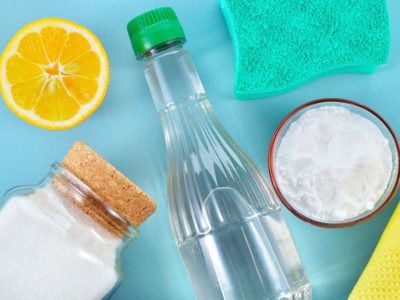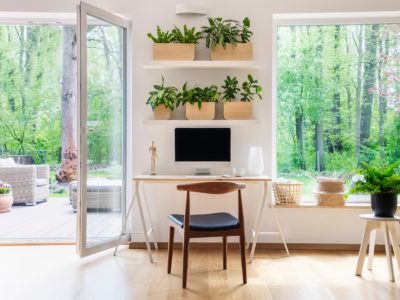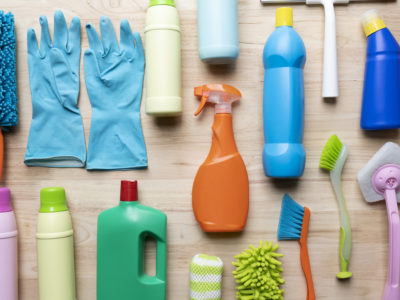Table of Contents[Hide][Show]
Coughing… itchy eyes… shortness of breath…
It’s easy to blame these on everything from seasonal allergies to “cold season.”
But it could be something much sneakier… something that surrounds you, yet you can’t see it.
The air you’re breathing.
With the average American spending over 150 hours per week indoors, the quality of indoor air can make a huge difference in your overall health.
Let’s take a look at some of the best ways to bring fresh, clean, toxin-free air into your home.
Why Your Body Needs Better Air Quality
Poor air quality is often called “the silent killer.” It can’t be seen or heard, but its health impacts can be devastating. In fact, the World Health Organization (WHO) estimates that 3.8 million people die each year due to indoor air pollution.
These are some of the ways poor indoor air quality can affect your body.
- Asthma attacks (for people who already have asthma)
- Chest pain
- Coughing
- Fatigue
- Itchy, irritated eyes
- Shortness of breath
- Sore throat
- Wheezing
Poor air quality can also increase the risk of the following conditions.
- Cardiovascular disease
- Lung cancer
- Respiratory infections
- Stroke
Best Ways to Improve Air Quality In Your Home
Raising the air quality inside your home can lower your risk of developing the health issues we discussed above. And, if you suffer from certain chronic conditions, better air quality can help you live a longer, healthier life.
Here are some tips to get you started.
Let Fresh Air In
As we mentioned, the air outside has a much higher quality than the air in your home. So opening the windows and letting in fresh air is one of the simplest ways to boost indoor air quality.
One window or door isn’t usually enough, though. You’ll need at least 2-3 openings, on opposite sides of the house, to create an airflow.
For efficiency and to save money, if you live somewhere with extreme temperatures you may need to limit the times you have doors or windows open. For example, in hot, humid places, you may want to let in fresh air early in the morning or in the evening/overnight. If it’s cold outside, you may want to wait until the weather warms up a bit.
Fresh air and proper ventilation are particularly important if you’re using chemical-laden products, including some cleaning supplies, paint or spray paint, etc.
Use an Air Purifier
Placed in rooms that are used the most, such as the living room and bedrooms, an air purifier can make a huge difference in the quality of indoor air. They’re particularly useful during allergy season, when microscopic pollen particles can make your allergies go haywire!
Regardless of the model, all air purifiers work in a similar way. They draw in dirty air, filter out the pollutants and contaminants, and release the purified air back into your home.
Here are some things to keep in mind when you’re shopping for an air purifier.
- Look for a model with a fan, which will do a better job at circulating the purified air around your room.
- Choose a model with a high Clean Air Delivery Rate (CADR). A higher number means that the unit will work faster at filtering your indoor air.
- Some models of air purifiers can also help filter out viruses. If this is a concern for you, make sure you choose a model that can effectively remove small particles (around 0.1-1 um).
Clean, Clean, and Clean Some More
You can make a big impact on your home’s air quality simply by establishing a regular cleaning schedule.
- Use the highest quality vacuum cleaner you can afford, to prevent a build-up of dust, pollen, germs, and pet hair. Be sure you vacuum under furniture, especially your bed and sofas—two places where people spend most of their time at home.
Also, use the vacuum attachments to clean upholstered furniture, cushions, curtains or drapes, and other hard-to-clean areas.
- Dust furniture and decor with a dust-trapping cloth or damp cloth. (Try Nanotowels for a greener option to paper towels. Plus, they clean virtually anything with just water!)
- Reduce indoor clutter. Decorative items are magnets for dust, germs, and other particles that negatively affect air quality.
- Shake kitchen and bathroom rugs outdoors to get rid of excess dust. If they are machine washable, make sure you wash them often.
- Change your sheets weekly. Wash comforters, duvet covers, and throw pillows regularly and at the manufacturer’s highest recommended temperature.
Choose Green Cleaning Products
Frustratingly, some of the very items you rely on to keep your home clean can actually be worsening the indoor air quality! The chemicals in some of these products can be incredibly toxic if you breathe them in.
Next time you stock up on cleaning products, look for eco-friendly “clean” products.
Some words to look for on labels include:
- Certified organic
- Green
- Non-toxic
- Fragrance-free
If you prefer scented products, you can always add a few drops of your favorite essential oils to unscented cleaning supplies.
Or, use all-natural products such as vinegar, lemon juice, and Castile soap (made from vegetable oils).
Related
10 Natural Cleaning Ingredients – Goodbye Toxic Products!
What you don’t know can’t hurt you. Unless we’re talking about cleaning products. In fact, so little is known on the effects to human health of cleaning products, it’s scary. Cleaning companies are not required to demonstrate if there are (or are not) any health or environmental risks associated with their products. The burden of testing …
Make Your Home a Smoke-Free Zone
If you have any doubts about whether or not to allow smoking inside your home, here’s a statistic that might sway you: just three cigarettes can cause more pollution than a diesel car’s exhaust.
However, even though most of us know not to smoke cigarettes, especially indoors, there are other products you might not have considered.
Incense, candles, and other “smell good” items that you burn inside your home can also release toxic particles, including carbon monoxide and carbon dioxide. If you’re a fan of yummy scents, we suggest burning all-natural candles, such as those made with beeswax or soy.
Reduce Dampness
Mold is one of the biggest culprits when it comes to poor indoor air quality, and it loves humidity. Dust mites and viruses also thrive in hot, moist conditions.
You can cut down on the dampness in your home with a few simple steps.
- Use the bathroom fan/vent after a hot shower or bath.
- Use the kitchen fan after cooking.
- Open windows to prevent the build-up of condensation.
- Use a dehumidifier, especially in damp rooms and in the summer when humidity is higher.
- Dry spills as soon as possible.
- Make sure windows and doors are sealed.
- Fix any leaking pipes.
- Dry clothes in the dryer; dry delicate fabrics outdoors.
Related
Why Is Mold Dangerous?
Learn more about the dangers of mold, signs that it’s present, who is most at risk, and how to prevent it from growing in your home.
Add a Few Plants
The right house plants might boost your indoor air quality, although more research on the subject is needed.
Some studies suggest that house plants can help purify indoor air, especially when used in conjunction with other measures. They can remove chemicals such as formaldehyde, toluene, benzene, and carbon dioxide, among others.
Not sure which plants to choose? Some of the best plants for purifying your home’s air include ferns, peace lilies, spider plants, dracaenas, and ivy—all easily found in nurseries or home and garden centers.
However, if any members of your household suffer from allergies, make sure you choose plants that don’t make them worse.
Also, make sure that you dust your houseplants regularly so they don’t collect dust.
Detoxing Your Body from Air Pollution
Constant exposure to poor air quality will result in a high number of pollutants in your body.
Taking measures to improve the air quality in your home will prevent that number from going up. And your body will naturally eliminate the most common toxins, thanks to its powerful antibodies.
Antibodies are proteins that bind themselves to unwanted intruders in your body, such as pollutants and neutralize them. They then help your body eliminate them. Boosting your antibody levels can help turn your body into a detox machine!
Some of the things you can do to raise your antibody levels include:
- Get enough sleep.
- Eat a healthy diet.
- Reduce stress.
- Exercise moderately.
You can also take an antibody-boosting supplement such as this one from Just Thrive. It contains more antibodies than any other product on the market, so it’s a workhorse for mopping up and eliminating toxins.
Some additional things you can do that will help your body flush out those harmful toxins are:
- Drink plenty of water. And move your body; sweating is another great way to flush out toxins.
- Increase your vitamin C intake. Citrus fruits are high in antioxidants, substances that fight the damaging free radicals found in pollutants, irritants, and allergens.
- Drink green tea, which is also packed with antioxidants.
- Hit the sauna. The heat increases your blood flow, which in turn increases the oxygen levels in your blood and creates more toxin-fighting white blood cells.
Final Thoughts
How clean is the air inside your home?
No matter how clean you think it is, here’s the truth: it could still be improved.
Better air quality can relieve allergies and certain health issues, along with boosting your overall quality of life.
And you don’t need to spend a ton of money for better air quality. Actions as simple as opening windows or choosing natural wax candles over toxic alternatives can help keep the air inside your home fresh and pure. Even better, these are things you can start doing today.
Your lungs—and your overall health—will be happy you did!
You May Also Like…






